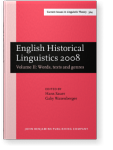Etymology and the OED
The uses of etymology in a historical dictionary
Etymology and historical dictionaries have a symbiotic role: etymology has a key structural role in a historical dictionary, and the data of historical dictionaries is crucial for making advances in the study of etymology. This chapter draws illustrative examples from the new edition of the OED currently in course of publication. The ‘words’ documented by historical dictionaries are often highly complex entities, showing considerable variation in form and meaning, and that variation is typically both diachronic and diatopic, as illustrated by the dictionary entry for poke ‘sack’. It is not always safe to assume historical continuity as opposed to polygenesis in a word history; this sometimes involves assumed relationships of cognacy, as illustrated by freedom. Even when words are monomorphemic, borrowing among cognates often cannot be ruled out, e.g. rash. Two phenomena that historical dictionary structures bring into sharp relief are what can be termed historical splits (e.g. ordnance, ordinance) and mergers (e.g. melt) in word histories; cases of partial or near mergers are particularly problematic (e.g. mean, mystery). Sometimes merger can be hypothesized to explain a problematic history (e.g. queer). In the final part of the chapter the power of explanations based on form change and on meaning change are contrasted: in spite of considerable theoretical advances in the latter area, the unpredictability and isolated nature of most cases of semantic change remains a considerable challenge for etymological research, even in the context of the rich semantic documentation of a historical dictionary.
